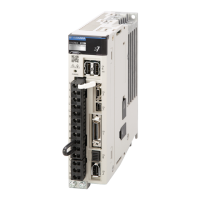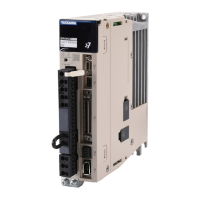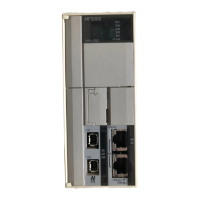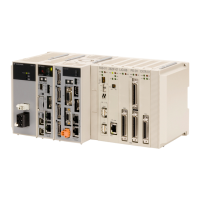5.12 Overtravel and Related Settings
5.12.1 Overtravel Signals
5-32
5.12.1
Overtravel Signals
The overtravel signals include the P-OT (Forward Drive Prohibit) and the N-OT (Reverse Drive
Prohibit) signals.
You can operate the Servomotor in the opposite direction during overtravel by inputting a refer-
ence.
5.12.2
Setting to Enable/Disable Overtravel
You can use Pn50A = n.X (P-OT (Forward Drive Prohibit) Signal Allocation) and Pn50B =
n.X (N-OT (Reverse Drive Prohibit) Signal Allocation) to enable and disable the overtravel
function.
You do not need to wire the overtravel input signals if you are not going to use the overtravel
function.
You can allocate the P-OT and N-OT signals to other connector pins. Refer to the following
section for details.
6.1.1 Input Signal Allocations on page 6-4
Type Signal Connector Pin No. Signal Status Meaning
Input
P-OT CN1-42
ON Forward drive is enabled (actual operation).
OFF
Forward drive is prohibited
(forward overtravel).
N-OT CN1-43
ON Reverse drive is enabled (actual operation).
OFF
Reverse drive is prohibited
(reverse overtravel).
When the Servomotor stops due to overtravel during position control, the position deviation is
held.
You must input the CLR (Clear) signal to clear the position deviation.
Refer to the following section for information on the CLR signal.
6.6.2 CLR (Position Deviation Clear) Signal Function and Settings on page 6-30
Important
Parameter Meaning When Enabled Classification
Pn50A
n.2
(default setting)
The forward overtravel function is enabled
and the P-OT (Forward Drive Prohibit) signal
is input from CN1-42.
After restart Setup
n.8
The forward overtravel function is disabled.
Forward drive is always enabled.
Pn50B
n.
3
(default setting)
The reverse overtravel function is enabled
and the N-OT (Reverse Drive Prohibit) signal
is input from CN1-43.
n.
8
The reverse overtravel function is disabled.
Reverse drive is always enabled.

